Menu
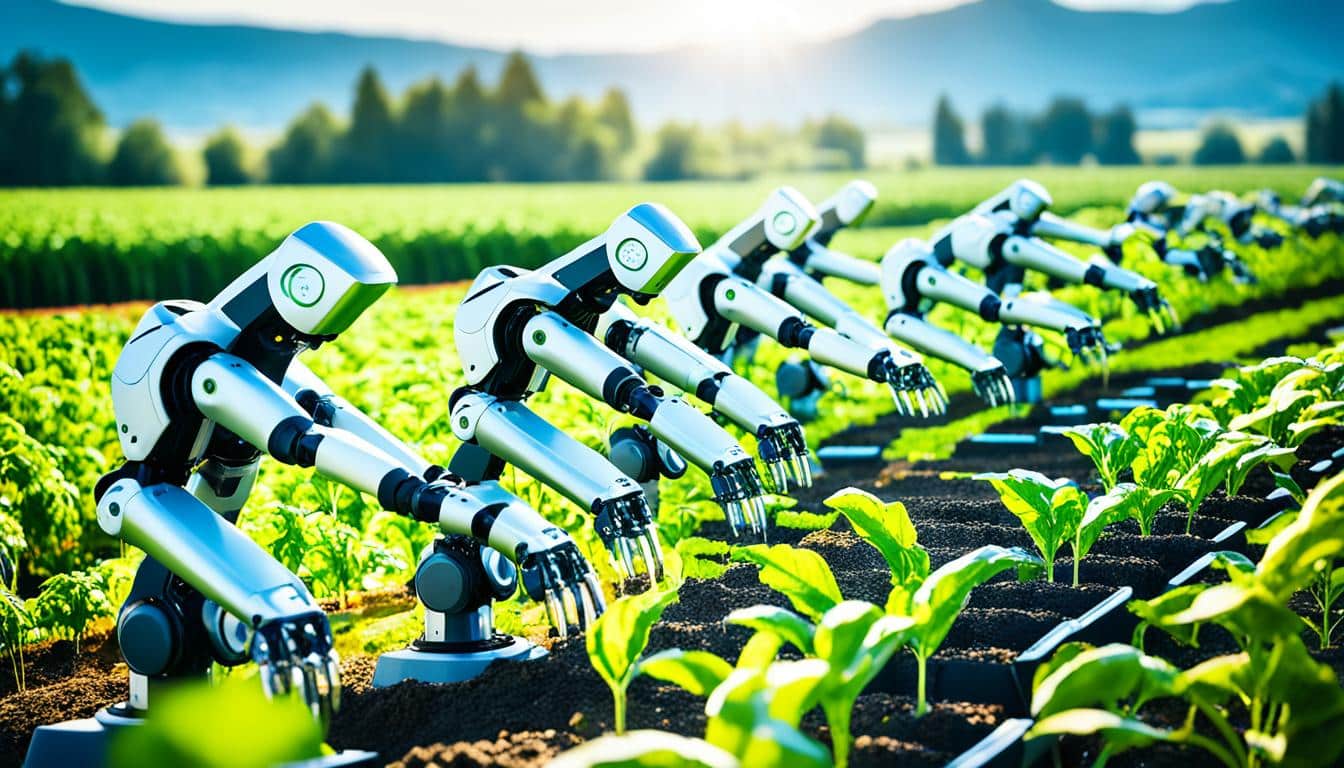
Did you know, the market for agriculture robots is set to grow? From $13.5 billion in 2023, it’s likely to hit over $40 billion by 2028. This jump shows how crucial farm robotics have become. They use AI and automation to make farming better. They boost efficiency, grow more, and cut down on waste. Now, robots handle everything, from planting seeds perfectly to managing livestock well.
Robots in farming help use resources smarter. They also tackle the big task of feeding more people by 2050. North America is leading in using these new technologies. Companies like Harvest Automation and Tortuga AgTech are doing amazing things. They’re making farming smart. In this way, farm robotics are really changing agriculture. They’re making it more efficient, costing less and better for the planet.
Farm robotics are changing the way we farm, leading us to better performance and results. They are not just a passing phase. They are needed to feed the world’s growing population efficiently. The use of farm robots is turning farms into precision-based, high-yield sites.
Today’s farm robots are amazing. They can handle tasks from planting to harvesting and even check on plant health. For example, the strawberry harvester from Harvest CROO is lightning-fast. It picks one plant every eight seconds and moves to the next in just one-and-a-half seconds. Tortuga AgTech’s robots are nearly perfect in fruit picking, boosting output and cutting down on wasted fruit.
Robots are not just for crops. They are also making farming animals more efficient. They feed, milk, clean, and even herd the animals. This makes farms run better and more dependably.
This tech doesn’t just finish tasks faster. It saves time and money, ramps up earnings, and makes farms greener and safer. With fewer young people working on farms and tighter immigration rules affecting labour, smart robots are becoming vital.
To sum up, farm robotics represent a key change towards a modern farming era. By embracing these techs, we can realise more productivity, greener practices, and superior farming methods. It sets the stage for a strong farming sector driven by innovation.
The world’s population is heading towards 9 billion by 2050. This growth means we need more food, pushing the agricultural sector hard. To meet these demands, farmers are increasingly looking to robotic technology. This shift aims to boost how much food we can grow in a sustainable way.
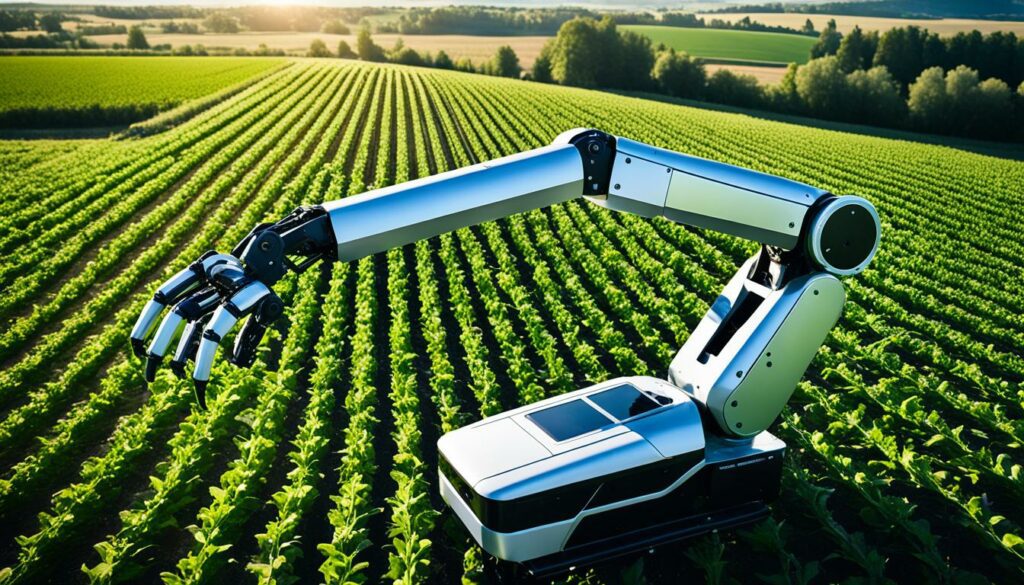
With more people needing food, current farming methods fall short. So, automated farming steps in. It helps grow more food using less space and fewer resources. This not only increases our food supply but also cuts down on water use and farming costs.
Automated systems use sensors, software, and machinery. They are at the heart of precision agriculture. These technologies help manage resources better, making farming more effective and efficient.
The world’s farms are facing a shortage of workers. This makes robotic farming tech crucial. It doesn’t just lower the need for human work but also grows better crops. Systems like AI-powered harvesters and irrigation bots point to the key part automation plays in farming today.
Leading companies such as Tortuga AgTech, Harvest CROO, and Naio Technologies are at the forefront. They offer cutting-edge robotics for farming tasks. Tortuga AgTech, for example, has robots that can pick fruit almost perfectly. This shows that tech in farming is not just important; it’s the future.
In recent years, we’ve seen big changes in farming thanks to robots. These new advanced robots work using smart AI. They can do tasks on the farm without much help from people. Tortuga AgTech’s robots, for example, pick fruit with amazing accuracy, up to 98%, on their own.
Companies like Harvest CROO and FFRobotics are also leading in this field. Harvest CROO’s robot picks strawberries incredibly fast, every 8 seconds. FFRobotics’ harvester is ten times quicker than a person. It’s supported by a big research grant in Europe.
Carbon Robotics has made a robot that uses lasers to remove weeds. It doesn’t hurt the crops, showing us how to farm very precisely. Scythe Robotics’ mower is smart too. It sees all around itself and moves easily around obstacles while it mows.
Nexus Robotics and Bowery Farming are also making huge strides. Nexus has a robot that finds the difference between crops and weeds. It can also check the health of the soil and the environment. Bowery combines robots, AI, and LED lights to grow plants in cities with very little water, but a lot of food.
AppHarvest in Central Appalachia is using AI and robots to farm indoors. This way of farming uses less water and makes more food in a better way for the planet. Drones flying over fields help farmers see if their plants are healthy and help them fight pests.
Last but not least, Wintergreen Research expects the market for farming robots to reach $16.3 billion soon, showing how helpful they are. Drones are now planting trees by themselves, putting 400,000 in the ground daily. This quick planting doesn’t need a lot of people to watch over it.
| Company | Robot Model | Function | Key Feature |
|---|---|---|---|
| Tortuga AgTech | N/A | Fruit Picking | 98% Accuracy |
| Harvest CROO | N/A | Strawberry Harvesting | 8 seconds per plant |
| FFRobotics | N/A | Fruit Harvesting | 10 times faster than humans |
| Carbon Robotics | LaserWeeder | Weed Control | AI and computer vision |
| Scythe Robotics | M.52 | Mowing | 12 sensors for navigation |
| Nexus Robotics | R2Weed2 | Weeding and Monitoring | AI for weed differentiation |
“Innovations in technological advancements in farm robotics have led to elevated efficiency, sustainability, and productivity in agriculture, ushering in a new era where AI-powered farm robots and autonomous agricultural robots play pivotal roles.”
Robotic tools in agriculture have changed how we grow crops, making it sustainable and efficient. They use advanced tech like AI and sensors. These technologies are changing farming for the better.
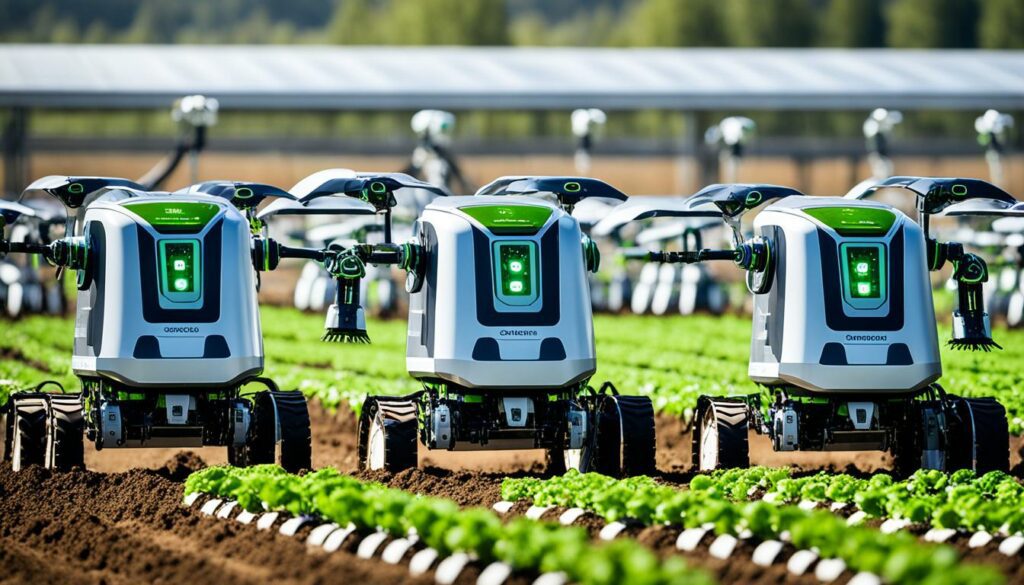
A major use of robots in farming is precision seeding. They use AI and sensors to plant seeds perfectly. This boosts crop production and cuts down on wasted farming chemicals by up to 99%.
| Robotics in Precision Seeding | Benefits |
|---|---|
| AI Algorithms | Accurate seed placement and reduced waste |
| Sensor Technologies | Optimised space usage and improved yield |
Robots also help keep an eye on crops closely. They use cameras and AI to check plant health. This helps with better soil use and smarter watering. The end result is more crops and less work for farmers.
| Robotics in Crop Monitoring | Benefits |
|---|---|
| Advanced Imaging Technologies | Comprehensive crop health analysis |
| AI-Driven Analysis | Optimised irrigation and soil condition evaluation |
Projects like AGROBOFOOD and BACCHUS show how much robotics can improve farming. They focus on making agriculture greener and more productive. By working together and using specialisations, they plan to change farming for the better.
As time goes on, robotic farming tools will be even more important. They are key to making sure farming stays productive and good for the environment. Precision seeding and watching over crops are just the start of what robots can do in agriculture.
The agriculture field is changing fast with the help of robotics. Livestock management has seen big changes thanks to robotic farming technology. Now, robots take care of milking, feeding, and checking animal health. This makes work more precise and keeps a closer eye on the animals. Automation is making farming smarter and more productive. It also helps the environment by being more sustainable.
Global spending on robotic farming hit over $6 billion in 2022. It’s expected to climb to $18 billion by 2030. The dairy industry, in particular, is making big moves towards using more robots. They’re adding hi-tech robotic parts to their milking systems. This change is making dairy farming more efficient.
As the world’s population grows, we need to produce food in a better way. Robots in farming are key to this. They offer careful treatment for the animals and save money. They also avoid the risks linked to using big machines and doing things by hand.
Robotic farming is also making farming more environmentally friendly. It lowers the amount of pollution and makes sure the animals are healthy. It helps with the lack of workers and the rising costs of farming too. Farmers are turning to robots for a more efficient and greener farm life.
Many governments around the world are supporting robotic farming with funds. This backing is encouraging innovation and the use of more robots in farming. It means a wide variety of robots are being used. This is good for farming as it helps in smarter farming and taking better care of animals.
In today’s world, using cost-efficient farm robotics is key. It helps cut agricultural costs and supports eco-friendly farming. These technologies make work smoother and bring lasting green benefits. They are vital for meeting global farming challenges.
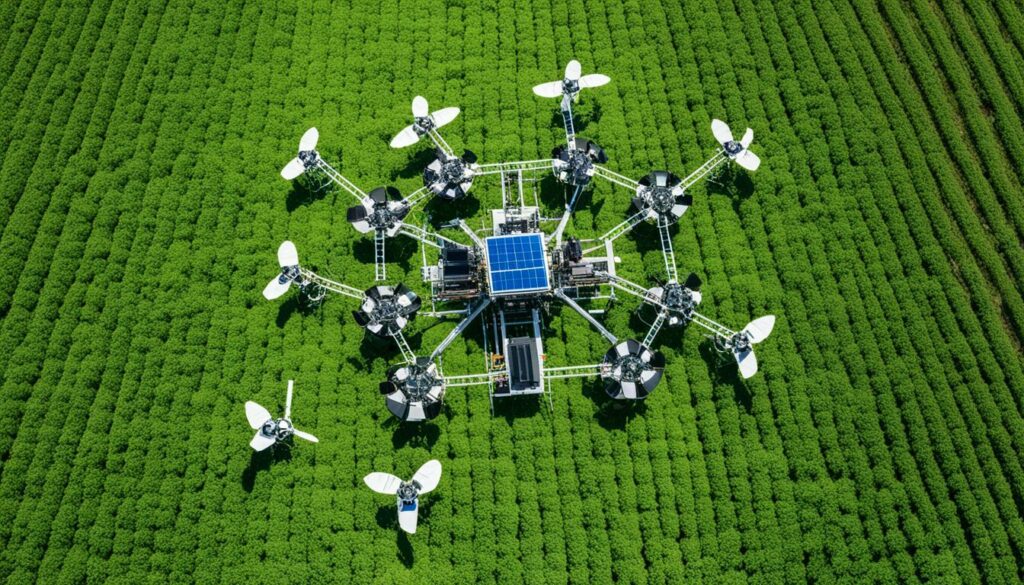
By adding farm robotics, farm costs go down. These systems help use seeds and fertilisers accurately. They also lower costs by doing hard jobs automatically. This change is big because more dairy farms will use these systems in the coming years. It shows farms are getting more efficient.
Using green farming is important to protect the planet. Robots are essential for this. They make caring for crops exact, like cutting weeds and bugs. This means less harm to the land from chemicals. Nitricity is leading in making fertilisers in a cleaner way, with fewer greenhouse gases. By using less energy and farming to help the land heal, farming becomes kinder to our planet. Cultivate Next is supporting these efforts with its technology. They back companies like Greenfield Robotics who make eco-friendly machines.
| Market Projection | Value |
|---|---|
| Estimated Market Size (2023) | $13.5 billion |
| Projected Market Size (2028) | $40 billion |
The market for farm robots will grow a lot, from $13.5 billion in 2023, to $40 billion by 2028. This shows that using these technologies is not just smart for the budget. It’s also vital for a green farming future.
The use of big data in farming and robotics changes how farms work. It makes decision-making more accurate and effective. Robots gather lots of current data, like the moisture in the soil and the health of animals. This makes farming more based on information and it works better. High-quality data helps make smarter choices. This makes different parts of farming work well.
The market for agricultural robotics is growing fast. It’s predicted to go from $13.4 billion in 2023 to $86.5 billion by 2033. This means there’s a 20.5% growth every year. Robots are used for seeding and fertilising in a precise way. This lowers costs and helps protect the environment.
Rooted Robotics is making it easier for farms to use technology inside. They offer affordable automation that works with artificial intelligence (AI). This lets farmers produce more, without wasting so much. Big data helps in the world of finance for farming. It gives a deep look into what’s happening in the market. This helps farmers get the money they need more easily.
Terra Robotics, a startup from Greece, shows how AI and robots can work together. Their robot weeds fields on its own, without chemicals. This is better for the environment and good for the farm.
Farming needs to be ready for a big increase in the world’s population. Big data can help farms be more productive and kind to the planet. It leads to a future where everyone can get enough food. This is thanks to new ways of farming that use AI and robots.
The role of big data in farming is very important. As the market for agricultural robots grows fast, using AI in farming will be crucial. It’s about more than just working better. It’s how to farm in a way that’s good for the future.
Autonomous farming equipment is changing how we farm. It uses AI and machine learning to do tasks better. This includes things like driverless tractors and harvesters.
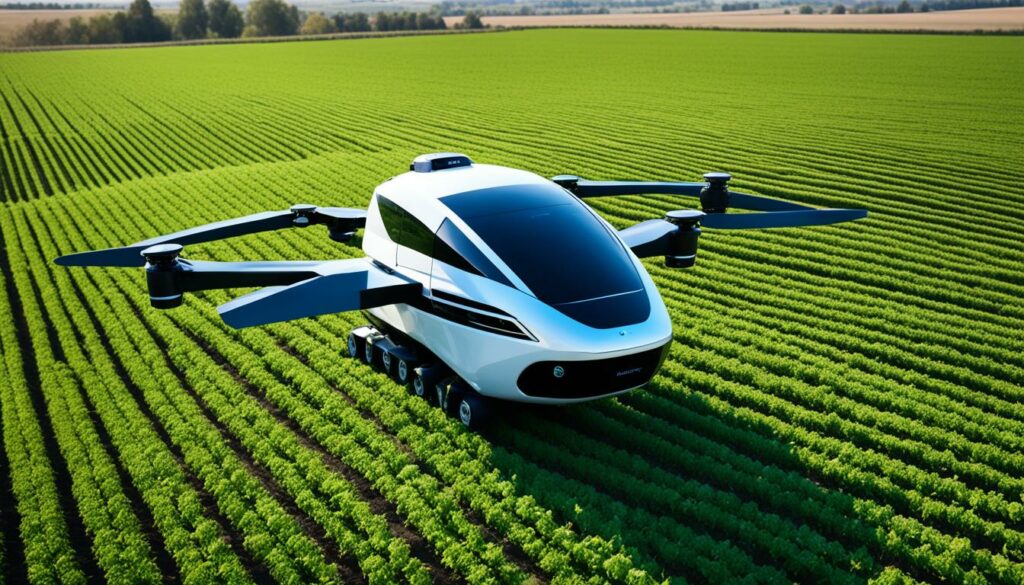
Driverless tractors are leading this revolution. They’ve come a long way since Ford’s “The Sniffer” in the 1950s. Now, with GPS and sensors, they can do a range of jobs without people.
This saves money and makes farming more efficient. Market experts predict a significant growth in their use.
Autonomous harvesters are another key part of this new era. They use advanced tech to pick crops. Back in 1994, a special system was made for a small, driverless tractor for special crops. Today, these harvesters can adjust in real-time to get the best harvests.
They not only grow better crops but also help with air shortages. This makes farming more sustainable.
| Equipment Type | Features | Advantages |
|---|---|---|
| Driverless Tractors | GPS Navigation, AI-enhanced Obstacle Detection | Reduced Labor Costs, Higher Efficiency |
| Autonomous Harvesters | Imaging Systems, Real-time Adjustments | Optimized Harvesting, Improved Crop Quality |
The use of AI and autonomous machines is promising for farming’s future. It will boost productivity and meet the needs of a growing population.
Although farm robotics offer big benefits, they face challenges in agricultural automation. High prices starting at $15,000 create a barrier, particularly for small and medium farms without enough money.
Many companies, like Burro and Farm-ng, have attracted major investments. But, the money they received still isn’t enough to make robotic farming truly common. This shows that more investment is necessary for the technology to become widespread.
Adoption challenges also include the need for specific technical knowledge to use and service these machines. This presents an obstacle. Farmers must get special training, adding to the costs and time involved.
Plus, the model of Robots-as-a-Service (RaaS) has not helped as much as expected. It faces issues in practicality and costs, limiting its iimpact.
With over half of farmers facing labour shortages, robotic solutions could be a big help. Advanced techniques can cut down pesticide use greatly. Robots could replace up to 30 workers in some tasks, showing their potential. But, we must first tackle the challenges in agricultural automation for these benefits to appear on a large scale.
The environmental upsides of using robots are significant. They can lead to a shift to less intensive crops and cut down on harmful chemicals. Still, overcoming the obstacles in the way of using robotic farming widely is crucial. This includes better training, innovative financial support, and resolving technical hurdles.
| Company | Funding | Purpose |
|---|---|---|
| Burro | $24 million | Harvest assist robots |
| Farm-ng | $10 million | Scaling Amiga robots |
| Neatleaf | $4 million | Indoor management platform |
| GreenField Incorporated | $5 million | Scaling weeding robots |
| Small Robot Co | Approx. $10 million | Initial funding |
In the farming world, big changes are coming with the rise of farm robots. By 2050, we need to produce 50% more food for our growing population. This is where AI and machine learning come in, promising to revolutionise our farming practices.
Artificial intelligence and machine learning are revolutionising farm work. These technologies boost farming’s efficiency and accuracy. For example, AI helps with autonomous precision farming, cutting down herbicide use by over 90%. This improves soil and wildlife health.
Machine learning also enhances crop management by using data to predict outcomes. This helps farmers make choices that boost their yields and save resources.
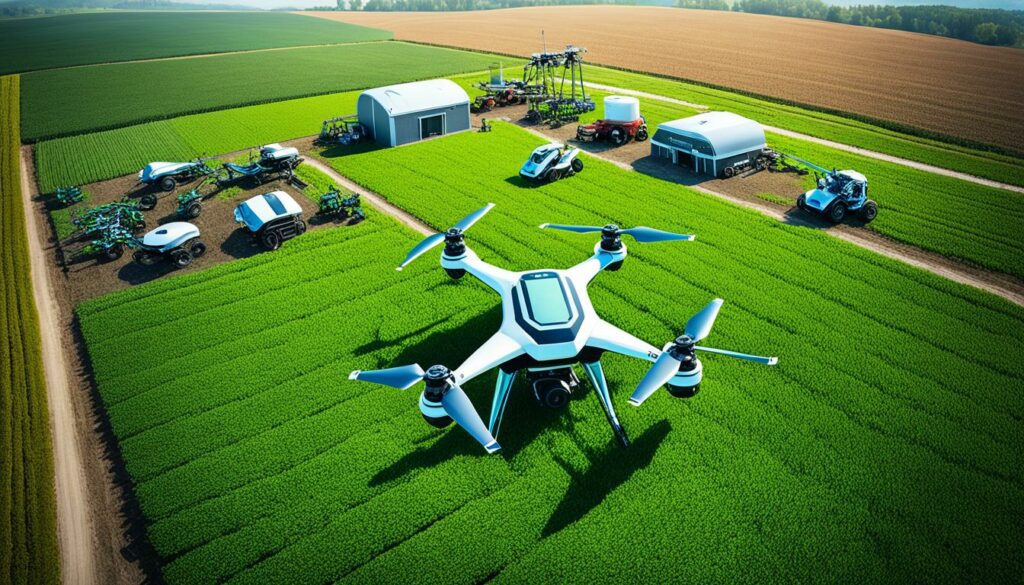
The future also brings us IoT in farming, connecting devices and data in real-time. This tech helps farming be more productive and eco-friendly. For example, IoT devices keep an eye on soil moisture, crop health, and weather. This ensures farming is precise and kind to our planet.
An example of this is the Crombot from Warwick Agri-Tech. It checks how ripe fruits are in greenhouses all by itself. This makes sure crops are looked after well.
Looking ahead, we’ll see more affordable mobile robots in farming. They will use smart algorithms to do many tasks. These robots will be great at planning paths, saving energy, picking the best soils, and avoiding obstacles. With the market for agricultural robotics growing fast, it’s clear that these technologies are here to stay. They are key for a future where farming is both sustainable and profitable.
Vertical farming is revolutionising agriculture with the help of robots. It uses just 1% of the space traditional farms do. This makes it perfect for cities, where space is limited. Smart farming robotics handle everything from planting to harvesting in a carefully controlled environment. This boosts efficiency and makes the most of resources.
One big advantage of vertical farming is it needs less water. It can reuse water thanks to a closed system. These farms work all year, producing fresh food no matter the weather. They don’t use pesticides, which makes the food safer and helps the crops grow better.
Robotic technology is key in vertical farming. It automates many jobs, like planting and picking. Robots also check on the plants, prune them, and more. These farms use special lighting and sensors to make sure the plants have the best conditions to grow in.
Robots don’t just make things more efficient. They also cut back on the need for people to do manual work. They help with everything from harvesting to packaging. Drones are part of the team, too. They check on the health of crops in tall buildings, making sure the plants are doing well.
The market for indoor farming, which includes vertical farming, is already worth $2.9 billion. That number could jump to $7.3 billion by 2025. This shows how important controlled farming is becoming. With AI and robots, farming can be more efficient than ever. This changes the game for how we grow our food.
| Aspect | Traditional Farming | Vertical Farming |
|---|---|---|
| Space Utilisation | 100% | 1% |
| Water Usage | High | Low (Recycled) |
| Pesticide Use | Necessary | Eliminated |
| Crop Yield | Seasonal | Year-Round |
| Labour Requirement | High | Reduced |
| Proximity to Urban Areas | Far | Close |
Vertical farming with robots is a major step towards better farming. It helps us grow more food without using as much space or water. This new technology overcomes old farming problems. It makes our food supply safer and better for the world.
The world of agricultural robotics is growing fast, thanks to top companies like FarmWise and Naïo Technologies. These firms are at the forefront of creating new tech to improve farming. With their advanced solutions, they’re changing the way farmers work.
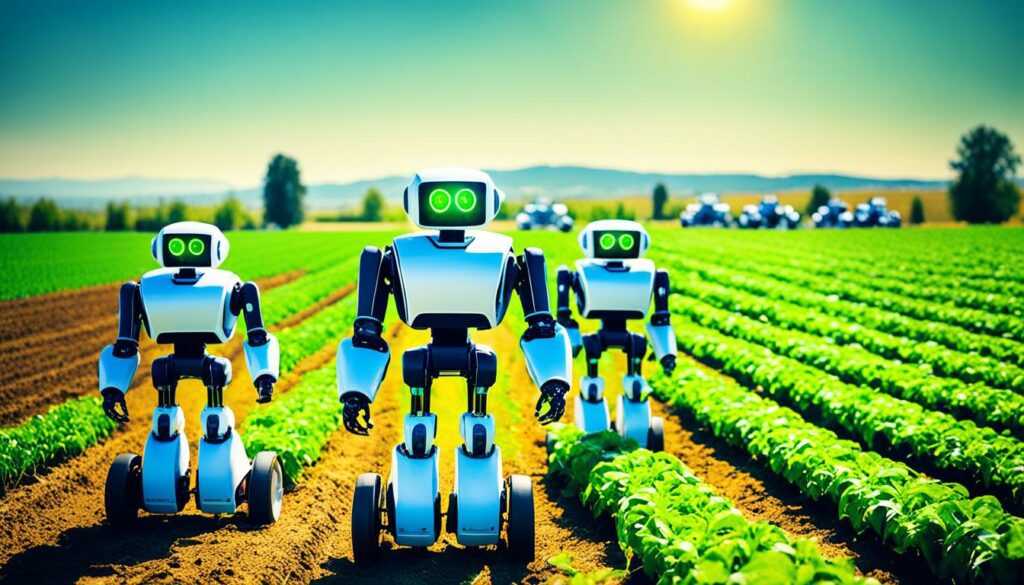
FarmWise is making a big impact with its focus on weeding using AI and computer vision. Their robots can find and remove weeds without needing herbicides. This not only makes farming more efficient but also helps the environment.
Experts compare FarmWise to about 250 other similar companies. They found that FarmWise is better at making robots that work on farms by themselves. They don’t need people to tell them what to do.
Naïo Technologies is known for its autonomous weeding robots that use less chemicals. These robots have smart navigation and vision, making them very precise in caring for crops. Their work in sustainability and efficiency matches the growing interest in farming technology.
A smart investor, Better Food Ventures, has even shown trust in them by funding their work. Naïo is helping make farming more autonomous and eco-friendly.
A detailed look at the market shows growth among 250 farm robotics startups. This study by The Mixing Bowl and Better Food Ventures points to a big shift towards farming tech. This creates a perfect environment for companies like FarmWise and Naïo to lead the way in making farming better.
| Company | Specialisation | Key Technologies |
|---|---|---|
| FarmWise | Weeding Operations | AI, Computer Vision |
| Naïo Technologies | Autonomous Weeding Robots | Autonomous Navigation, Vision Systems |
As farming faces more challenges, the support for farm robots from governments is crucial for growth. Recognising the role of robots in farming, many countries are creating policies to help. The USDA and NSF have put in about $200 million for this from 2017 to 2021.
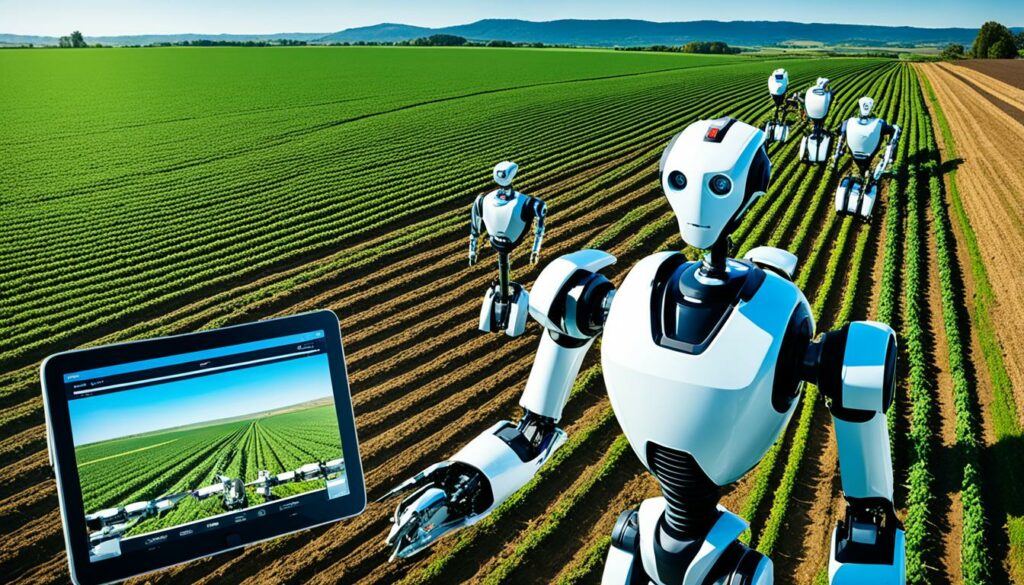
In the U.S., only 27% of farms use advanced technology. This shows the importance of good policies to encourage more farms to use robots. Governments can help by offering money, grants, and things to make robots cheaper. They need to work on issues like who owns farm data and making rules the same everywhere.
Worldwide, countries are working to boost the use of robots in farming. For example, in 2018, farming made up 18% of India’s GDP. To keep or grow these numbers, governments are helping farmers and scientists work together. This helps use money better, cuts down on waste, and helps the environment.
By 2050, we will need 70% more food because the population is growing. Robots in farming can help make more food without harming the environment. This change can help over 820 million people that don’t have enough to eat. It also saves water, since farming uses most of it.
To sum up, working together on rules and using new technology can make farming better. This will help make sure there’s enough food for everyone and protect our planet. This is key for agriculture to be both sustainable and efficient for the future.
The use of robots in farming has led to several exciting examples. These stories show the big advantages and lessons from using robots on farms.
Tortuga AgTech is a standout. Their robots can pick fruit with 98% accuracy. And only one person needs to watch the robots. Harvest CROO has a cool strawberry-picker. It takes eight seconds to pick a plant and moves to the next one in just one-and-a-half seconds. This shows how much robots can speed up the work.
FFRobotics has made fast fruit harvesters, doing the job ten times quicker than people. For instance, for picking apples. Carbon Robotics uses AI in a weeding robot. It tells crops from weeds. This makes the plants better and lowers costs.
Scythe Robotics makes self-driving lawnmowers. They help with keeping properties neat, using AI. Naio Technologies has robots for weeding. Their weed killer robot is famous at Château Mouton-Rothschild.
The lessons from using robots in farming are important. Nexus Robotics made R2Weed2, a clever weeding robot. It doesn’t just remove weeds. It also checks the soil and the environment. This helps farmers with better information.
Bowery Farming uses robots, AI, and special lights to farm in cities. This method uses 90-95% less water but still grows as many crops. AppHarvest also uses AI and robots for farming indoors. They use less water, get more crops, and watch their plants better.
| Company | Technology | Key Benefit |
|---|---|---|
| Tortuga AgTech | Autonomous Fruit-Picking Robots | 98% Accuracy, one-person supervision |
| Harvest CROO | Strawberry-Harvesting Robot | Picks plant in 8 seconds, transition in 1.5 seconds |
| FFRobotics | Robotic Fruit Harvester | 10 times faster than humans |
| Carbon Robotics | LaserWeeder with AI | Enhanced crop quality, reduced costs |
| Scythe Robotics | Autonomous Electric Mowers | AI for sustainability and efficiency |
| Nexus Robotics | R2Weed2 – AI-Powered Robot | Weed distinction, soil analysis, environmental monitoring |
| Bowery Farming | Robotics with AI and LED Lighting | 90-95% water reduction, maintained crop yields |
The future of farm robotics looks bright. Studies say the global market for farm robots will grow from $13.4 billion in 2023 to around $86.5 billion by 2033. These new technologies, like self-driving robots and AI farming systems, will make farming better and more sustainable.
Thanks to things like AI, machine learning, and big data, farming tasks are changing. Robotic systems help plant, harvest, and keep an eye on crops. This leads to healthier plants, less waste, and more efficiency. It shows how important agriculture technology is for the future of farming.
Innovative companies, such as Rooted Robotics and Terra Robotics, are leading the way in vertical farming and organic weed control. Although the future looks promising, there are still challenges. High costs and needing more skilled workers are big issues. We must face these challenges. By doing so, we can use farm robotics to feed more people, sustain our planet, and make farming more efficient.
Farm robotics are automated machines and tech that help with farming. They make work easier and more efficient. This includes smart farming robots and self-driving farm equipment.
Agricultural automation is changing farming by reducing mistakes and costs. It uses smart robots and machines that don’t need people to control them. This makes farms more productive and efficient.
The world’s population is growing fast. By 2050, we could reach 9.7 billion people. But there aren’t enough farm workers. Agricultural automation helps produce more food using fewer people.
There have been many advances in farm robotics. Now, robots can learn, use maps, and work on their own. We also have drones and laser scarecrows. These things help farms run better.
Precision seeding means planting seeds in a very accurate way. Agricultural robots with smart algorithms and sensors are used. They plant seeds exactly where they should be. This helps crops grow better and uses resources well.
Livestock robots help by milking, feeding, and checking the health of animals. They make sure animals are healthy and cared for properly. This fits with the goals of making farming smarter and more efficient.
By using farm robots, costs go down because work is automated. This also uses resources better. Robots help farms not waste as much, use less chemicals, and be kinder to the environment.
Big data in farming is very important. It gives lots of information in real time. This information, teamed with AI, helps farmers make better decisions. It leads to more efficient and effective farming.
Autonomous equipment means it works without people controlling it. Like driverless tractors and harvesters. They are very precise, work well, and make farming more productive.
There are some challenges with farm robots like the cost and needing people who understand the tech. But with proper training and financial help, these challenges can be dealt with.
In the future, we will see more AI and IoT in farm robotics. This will make machines smarter and better at their jobs. They will be able to do more complex tasks on their own.
In vertical farming, robots are used for planting, looking after, and picking crops in closed spaces. This way of farming saves space, uses resources well, and helps feed people in cities.
FarmWise and Naïo Technologies are big players in farm robotics. They make smart robots for weeding. This helps farming be more effective and friendly to the environment.
Governments help farm robotics by offering money and making rules that are good for robots in farming. This makes it easier for farmers to use new tech and helps with new ideas and money for research.
There are many successful stories about robots in farming. They show how robots can make farming better and more efficient. These stories are evidence that robots are changing farming for the better.